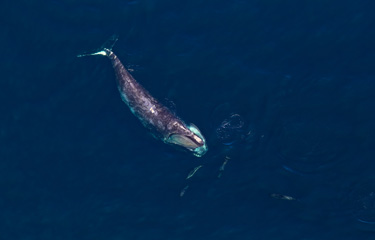A review of 20 years of data tracking the critically endangered North Atlantic right whale shows the population has shifted its feeding and migration patterns significantly as sea temperatures in the Gulf of Maine have warmed due to climate change.
Published this month in the journal Global Change Biology, “Decadal‐scale phenology and seasonal climate drivers of migratory baleen whales in a rapidly warming marine ecosystem” focuses on how the changing ocean climate affects whale phenology – the study of recurring biological events, tracking when plants flower each year, or when animals migrate.
The findings show that government-enforced protections for right whales – already requiring restrictions on vessel speed limits and fishermen’s lobster and fish trap lines and buoys – will need to be adjusted as the whales shift their movements and habitats.
After at least two decades of warming waters in the Gulf of Maine, right whales – a population now estimated at just 336 animals at risk from ship strikes and entanglements in fishing gear – are relying much more on Cape Cod Bay as their food supply has changed.
“The time of year when we are most likely to see right and humpback whales in Cape Cod Bay has changed considerably, and right whales are using the habitat much more heavily than they did 20 years ago,” said Dan Pendleton, a research scientist at the New England Aquarium’s Anderson Cabot Center for Ocean Life, in a summary issued by the aquarium. Pendleton was the lead author of the study and part of a team of whale scientists in the U.S. and Canada that collectively authored the paper.
The researchers went over more than 20 years of data showing trends in movements for right whales, humpback whales, and fin whales. They found that peak use of Cape Cod Bay has shifted almost three weeks later for right whales and humpbacks, correlating with warming spring climate conditions.
Activity by right whales in the bay increased from February to May, with greatest increases in April and May, according to the study. The researchers think right whales may be inhabiting Cape Cod Bay for longer periods of time because climate change has reduced the amount of their food elsewhere across the Gulf of Maine.
“These changes may have turned the bay into a sort of ‘waiting room’ for right whales as richer prey resources develop in new habitats, such as the Gulf of Saint Lawrence,” according to the researchers.
Along with New England Aquarium researchers the study included scientists from the University of Massachusetts Amherst; the U.S. Geological Survey Northeast Climate Adaptation Science Center; the Center for Coastal Studies; University of California Los Angeles; the National Marine Fisheries Service and Canadian Whale Institute.
The Cape Cod, Massachusetts-based Center for Coastal Studies’ aerial whale surveys from 1998 to 2018 were analyzed along with environmental data, including sea surface temperatures and dates that signify the start of spring each year.
The team used a novel statistical technique to study changes in whale habitat use within and across years, which provided insights into the long-term effects of climate change on whale movements.
The study focused on the Gulf of Maine because it is one of the fastest-warming ocean regions, evident in the decline of its northern shrimp fishery and shifting groundfish habitat. Changes in sea surface and bottom temperatures in the gulf are three times faster than global averages, according to the New England Aquarium.
The climate trends in the Gulf of Maine may have led right whales to linger longer in Cape Cod Bay, before making the trek north to the Gulf of Saint Lawrence when food is more plentiful there, the researchers wrote. While they are in Cape Cod Bay, right whales are swimming in waters heavily trafficked by shipping, commercial fishing, and recreational boats.
“Vessel speed limits and fishing restrictions in Cape Cod Bay were designed to coincide with the historical peak in North Atlantic right whale habitat use,” the New England Aquarium said in a press release. “The research illustrates the continued need for government agencies to alter protective measures for threatened and endangered whales, as those animals adapt to their feeding and migration patterns in response to climate change.”
Pendleton said the study’s finding could have implications for protection efforts for the whales.
“Changes in when whales use their traditional habitats has important implications for the design of protected areas. This issue is especially important as climate change continues to alter animal migrations,” Pendleton said.
Reporting by Kirk Moore
Photo courtesy of Porco_Rosso/Shutterstock







